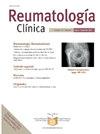Improving fracture risk classification in Spain: A 10-year evaluation of a modified FRAX-based algorithm
IF 1.3
Q4 RHEUMATOLOGY
引用次数: 0
Abstract
Objective
Osteoporotic fractures represent a significant clinical and public health burden. Although FRAX is widely used to estimate 10-year fracture risk, its Spanish version underestimates the probability of major osteoporotic fractures (MOF). This study assessed the performance of a modified FRAX-based algorithm, calibrated for the Spanish population, to stratify postmenopausal women into clinically meaningful risk categories.
Methods
We retrospectively followed 837 women (mean age 62 ± 9 years in 2008) referred for bone densitometry. All MOF over a 10-year period were recorded. Women were initially categorized as low risk (MOFR < 3.5%) or high risk (≥10%). Those with MOFR between 3.5% and 10% were reclassified as high risk if they had osteoporosis or if the recalculated MOFR including BMD was ≥7%.
Results
A total of 124 women experienced a MOF (66 vertebral, 39 distal forearm, 10 hip, 9 humerus). Initial risk classification identified 40% of women as low risk (fracture incidence: 9.4%, 95% CI: 6.2–12.5), 42% as intermediate (16.3%, 95% CI: 12.4–20.1), and 18% as high risk (23.5%, 95% CI: 16.7–30.3). After reclassification, 69% were considered low risk (11.0%, 95% CI: 8.4–13.5) and 31% high risk (23.2%, 95% CI: 18.1–28.3).
Conclusions
The proposed FRAX-based algorithm improves fracture risk classification in Spanish women and supports more rational use of bone densitometry and therapeutic interventions.
改进西班牙骨折风险分类:改进的基于frax算法的10年评估
目的骨质疏松性骨折是严重的临床和公共卫生负担。尽管FRAX被广泛用于估计10年骨折风险,但其西班牙语版本低估了主要骨质疏松性骨折(MOF)的概率。本研究评估了一种改进的基于frax的算法的性能,该算法针对西班牙人群进行了校准,将绝经后妇女分为临床有意义的风险类别。方法回顾性随访837例骨密度测定妇女(2008年平均年龄62±9岁)。记录了10年期间的所有MOF。女性最初被分类为低风险(MOFR < 3.5%)或高风险(≥10%)。MOFR在3.5% - 10%之间的患者如果患有骨质疏松症或重新计算的MOFR包括BMD≥7%,则被重新归类为高风险。结果124例女性发生MOF(66例椎体,39例前臂远端,10例髋关节,9例肱骨)。初始风险分类确定40%的女性为低风险(骨折发生率:9.4%,95% CI: 6.2-12.5), 42%为中等风险(16.3%,95% CI: 12.4-20.1), 18%为高风险(23.5%,95% CI: 16.7-30.3)。重新分类后,69%为低风险(11.0%,95% CI: 8.4-13.5), 31%为高风险(23.2%,95% CI: 18.1-28.3)。结论提出的基于frax的算法改善了西班牙女性骨折风险分类,支持更合理地使用骨密度测量和治疗干预措施。
本文章由计算机程序翻译,如有差异,请以英文原文为准。
求助全文
约1分钟内获得全文
求助全文
来源期刊

Reumatologia Clinica
RHEUMATOLOGY-
CiteScore
2.40
自引率
6.70%
发文量
105
审稿时长
54 days
期刊介绍:
Una gran revista para cubrir eficazmente las necesidades de conocimientos en una patología de etiología, expresividad clínica y tratamiento tan amplios. Además es La Publicación Oficial de la Sociedad Española de Reumatología y del Colegio Mexicano de Reumatología y está incluida en los más prestigiosos índices de referencia en medicina.
 求助内容:
求助内容: 应助结果提醒方式:
应助结果提醒方式:


